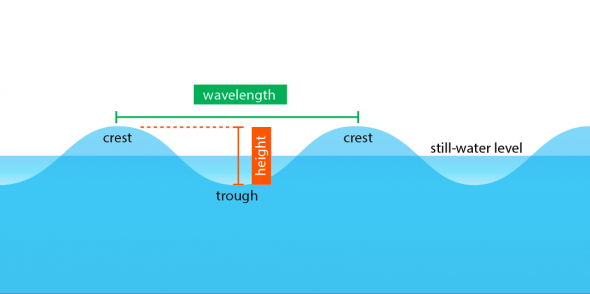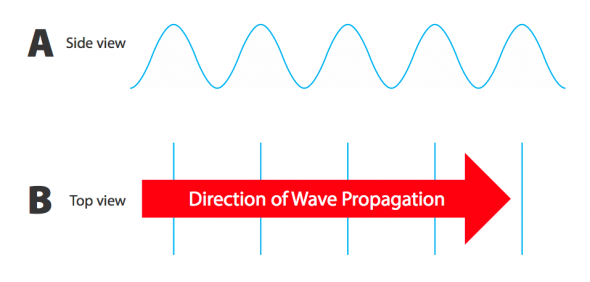Wave and Wave Properties
Waves
The word wave may bring to mind images of the ocean or a lake, but waves can occur in several different forms. The two main types of waves are mechanical waves and electromagnetic waves. Mechanical waves are disturbances in any medium or substance. Examples of mechanical waves include the movement of water, from ripples in a puddle to giant rolling waves on the surface of the open ocean. A plucked, vibrating guitar string represents a mechanical wave, as does the sound wave it produces by disturbing the air around it.
┬Ā
Electromagnetic waves do not need to move through a substance in order to propagate energy. Electromagnetic waves are disturbances or oscillations in electrical and magnetic fields. Examples of electromagnetic waves include visible light from a streetlamp, ultraviolet light from the sun, and radio waves transmitted and received by a mobile phone. Both mechanical and electromagnetic waves are capable of transferring energy. For example, water waves (mechanical waves) can transfer energy across an entire ocean basin, even though individual water molecules do not travel great distances.
┬Ā
Sources of Waves
Waves are caused by a physical disturbance or vibration. The force of blowing wind is the physical disturbance that generates most water waves. Such waves are termed wind waves. Wind wave patterns change with seasonal wind patterns. For example, during the winter, waves on the northern shores of the Hawaiian Islands can be very large. These large winter waves usually originate from seasonal storms in the North Pacific ocean basin.
┬Ā
Although most water waves are caused by wind, there are other sources of waves. Tsunamis┬Āare waves caused by movements of the earthŌĆÖs crust, such as earthquakes. Tsunamis are unpredictable and can rise unexpectedly from the sea and level whole coastal communities. Tidal waves are caused by the gravity of the moon and the sun. Tidal waves cause water levels in the ocean and lakes to rise and fall on a regular, predictable basis, covering shores during high tide and exposing them during low tide.
┬Ā
Watching Waves
The best way to learn about waves is to observe them. In addition to ocean waves, waves can be observed on windy days in lakes or rivers or, on a smaller scale, in swimming pools, puddles, and even a glass of water.
Describing Waves
|
The north and west shorelines are flat today. Town (south shore) spots are bumpy, inconsistent and struggling for a 0.5 m set. Diamond Head, SandyŌĆÖs and Makapuu are 0.25ŌĆō0.5 m. Tradewinds 15ŌĆō25 knots with clearing skies. Extreme low tide in the morning. Fat high tide at 3:00 pm. ┬Ā We have an out of season NNW as well as a South swell that are on their way. We are looking at a bump for all shorelines this weekend, especially by Sunday we should be looking at solid 1 m for the South and North shores. |
┬Ā
This surf report describes the consistency and size of waves and the wind. The tides are noted because they affect the shape and location of waves. The report also gives a forecast of future wave conditions.
┬Ā
|
Crest Trough Wave height (H) Amplitude (A) Wavelength (L) Wave period (T) ┬Ā Thu, 04/16/2015 - 09:41
Wave frequency (F) ┬Ā Thu, 04/16/2015 - 09:41
Wave speed (S) ┬Ā Thu, 04/16/2015 - 09:41
Still-water level Wave direction |
┬Ā
Fig. 4.2. Profile of a standing water wave
Image by Byron Inouye
To represent these attributes visually, scientists may use a wave profile diagram (Fig. 4.2). A wave profile is a side view of a wave and is used to show wave features including crests, troughs, wave height, and wavelength. In order to describe a set of waves traveling in a specific direction, scientists use top-view wave diagrams (Fig. 4.3), where vertical lines represent the consecutive troughs or crests of waves. An arrow is used to depict the direction of propagation (movement) of the waves.
┬Ā
Fig. 4.3. Diagram showing two views of waves. The side view (A) shows a wave profile with several crests and troughs. The top view (B) shows the same waves with vertical lines representing the wave crests traveling in the direction represented by an arrow.
Image by Byron Inouye
┬Ā
┬Ā
Calculating Wave Properties
By mathematically relating wave properties, it is possible to gain valuable information about wave behavior. The basic properties of waves are measurable in units of distance and time. Two properties that can be measured directly are wavelength (L), which is the distance or length from wave crest to wave crest, and period (T), which is the time it takes a wave to pass a fixed point (Fig. 4.2).
┬Ā
Wave Speed
Wave speed is often reported in standard scientific units of meters per second (m/s), but can also be reported in meters per minute (m/min) or other units of distance per unit of time. Knowing wavelength and wave period, the wave speed (S) can be calculated by dividing wavelength (L) by time, or period (T). For example, if a wave has a wavelength of 20 meters and a period of 4 seconds, wave speed can be calculated by dividing 20 m by 4 s, which is equal to 5 m/s.
┬Ā
Wave Period
In order to determine the period of a wave, it is necessary to know the amount of time between waves. Period is usually measured in seconds per wave. To determine period (T), wavelength (L) is divided by speed (S). For example, to find the period of a wave with a speed of 6 m/s and a wavelength of 12 meters, divide the length by the speed; 12 m divided by 6 m/s equals 2 s.
┬Ā
Wave Frequency and Wave Period
To calculate wave frequency and period, it is helpful to remember the inverse relationship between these two properties. Frequency is measured in waves per second and period is measured in seconds per wave. For example, if the period is 2 seconds, then the frequency is 0.5 waves per second.
┬Ā
Make Your Own Wave
Use your knowledge of wave properties to create a wave worksheet, share your worksheet with a classmate.
Standing Waves
Create standing waves in a wave tank and look at the effect of frequency and length of wave pulse on wavelength, wave height, wave speed, and wave period.
┬Ā
Standing waves are waves that do not appear to move forward or advance in position. Rather, they oscillate or vibrate in place. A plucked guitar string is an example of a standing mechanical wave with two fixed ends. Standing waves occur when waves with the same frequency, wavelength, and amplitude interact. In contrast to standing waves, transverse waves advance in position. Water waves on the surface of the ocean do not typically behave like standing waves. Instead, they behave like transverse waves, propagating their energy forward as they move.
┬Ā
┬Ā










